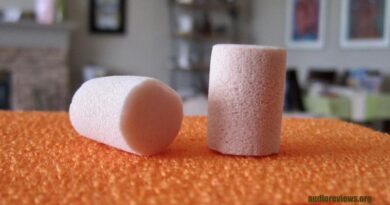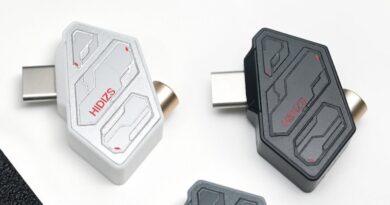FiiO RR11 FM Radio REVIEW – What’s The Frequency Kenneth?
The $50 FiiO RR11 radio/amp was kindly provided by the company for my review – and I thank them for that. You can get it from the FiiO Audio Store.
The FiiO RR1 is a well-built, sleak digital radio with an analog dial covering three FM bands for worldwide reception. It doubles as a headphone amp. Instead of a loudspeaker, it features a 3.5 mm headphone jack.
PROS
- Good sound
- Stable reception
- Great build and haptic
- Small and useful
CONS
- Non-servicable battery (planned obsolescence)
- Relatively small battery capacity
- Needs a 5V charger and does not work with modern fast chargers.
In this Article
Introduction
Back in late 1979, a band called “The Buggles” gained fame with their single “Video Killed The Radio Star”. The lyrics relate to concerns of behaviour towards 20th century technical inventions and machines back in the 1960s.
Nevertheless was the song forward looking as Music Television “MTV” appeared two years later offering a video to every song. I could not be bothered watching these clips once they had finally arrived in Europe as I found that the moving pictures took away from the imagination the songs provided.
Wireless sound transmission goes back to the late 19th century invented by the likes of Heinrich Hertz and Nikola Tesla. Commercial broadcasts with tube transmitters started shortly after WWI on both sides of the Atlantic.
Over the airwaves broadcasting flourished until internet and digitalization took over. Tubes and transistors became history. Distance did not play a role anymore, the signals come in crystal clear from afar. No need anymore for the dreadful AM radio sound.
Today, many listeners tune in via their mobile phones as digital data have become affordable. Car drivers rely largely on satellite feeds.
Nevertheless can radio waves still be received the old way. At home, we tune 24/7 into CBC (Canadian Broadcasting Corporation) with our Universum KRN-356 radio from 1982. In my home office, the bedroom, and two bathrooms, we operate diverse Sony radios and boom boxes. Analog radio is still alive and kicking in our household. None of these is digital.
Hey, don’t call me old!
In North America, Sony Walkmen featured built-in radios, and they still work today even when the cassette players’ belts have disintegrated. BUT, these boxes are big.
FiiO are coming to the rescue of radio listeners on the go with their RR11 model. It is the latest addition to their current retro series. We have already looked at their TT13 record player, their CP13 personal cassette player and their CM13 BT personal CD player.
In all cases, FiiO combine vintage and modern technologies. For example, their TT13 record player comes with a remote, their CP13 cassette player has modern amplification, and their CM13 BT CD player features Bluetooth.
The RR11 offers a modern potentiometer (instead of a scroll wheel) and a modern radio chip for optimal selectivity/proximity selection, that is its ability to separate the desired transmitter from a closely neighbouring transmitter.
Specifications FiiO RR11
| Frequency Modulation (FM) | FM1: 87~108MHz (standard frequency bad), FM2: 76~90MHz (Japan frequency band), FM3: 64~87MHz (school campus frequency band) |
| FM Radio Chip | Silicon Labs Si4831 |
| Status Indicator | Stereo indicator, frequency pointer, radio indicator, battery level indicator |
| USB Port | Type-C USB (charging port, analog input) |
| Headphone Port | Standard 3.5mm port |
| Battery | 300 mAh for 8.5 h (FM mode) or <17.5 h (amp mode) continuous play |
| Charging Time | 2 h |
| Product Page | fiio.com |
| Tested at | $50 USD |
| Purchase Link | FiiO Audio Store |
| More Detailed Specifications | fiio.com |
Physical Things and Functionality
In the box are the radio/amp, a white USB charge cable, a black USB-C cable with digital to digital converter for amp use with digital music source, a set of earbuds with three pairs of covers.
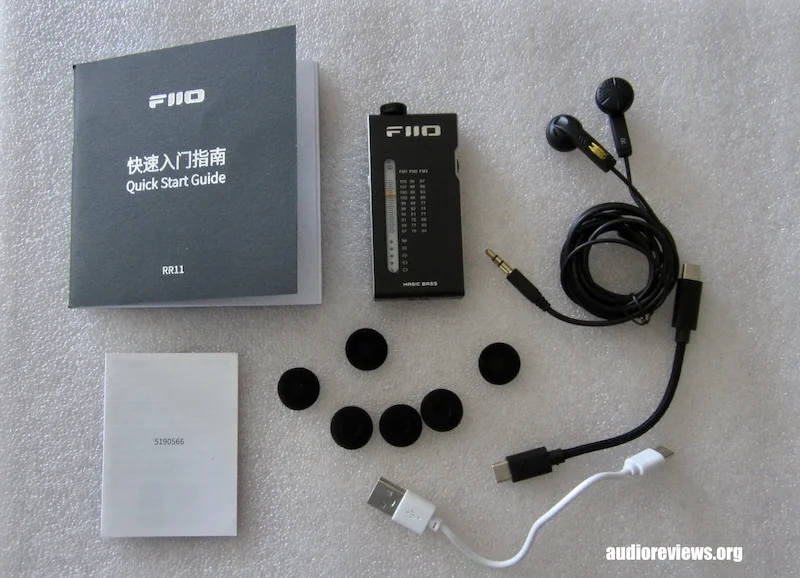
Technology, Functionality and Operation
The RR11 features a Silicon Labs Si4831 FM radio chip in its core. It receives a digital radio signal and converts it into analog. The mechanical station dial mimics an analog PVR (Phase Voltage Regulator) tuning, like in grandma’s kitchen radio. The radio chip handles the whole process chain from antenna input through decoding to audio output and provides a robust reception.
The RR11 has a built-in antenna, but it also uses the earphone cable as such. 3 FM bands enable ultra wide FM can coverage and therefore worldwide reception:
- FM1: 87-108 MHz FM1: Standard frequency band
- FM2: Japan frequency band 87-108 MHz
- FM3: School campus frequency band

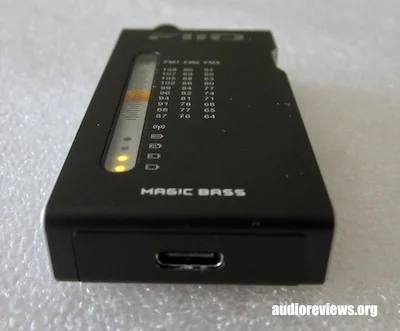
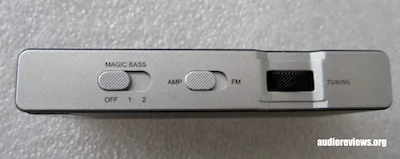
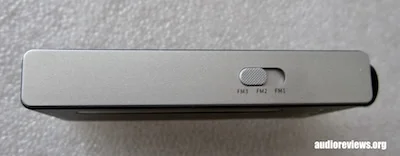
FiiO’s own circuit provides the perceived analog sound with a two-stage “Magic Bass” bass boost including 3D sound effects.
The RR11 can also be used as a headphone amplifier (with analog sound) that comes in handy when your phone lacks a headphone jack. This ONLY works with the included DIRECTIONAL USB-C to USB-C cable. I speculate, his cable contains a digital to digital converter. Using an Apple USB-C cable between iPhone 16e and RR11 did not work!
The analog dial is illuminated by yellow LEDs indicating the signal strength, stereo status, and battery level.
Traditionally, the Silicon Labs Si4831 FM radio chip is operated with two AA batteries…such do not fit into the small RR11, which utilizes a 300 mAh lithium battery. Continuous play, according to specs, yields up to 8.5 h radio play and up to 17.5 h in amp mode. In my testing at low volume, continuous radio reception had drained the battery after exactly 8.5 h. The LED battery indicators do not work in a linear manner: they showed 50% empty after 3.5 hours, the radio played for another 5 hours thereafter.
In comparison, any of my old battery operated analog radios runs at least 80 hours. A 900 mAh AAA (rechargeable) battery would triple the RR11’s playtime between charges.
Charging the RR11 only works with “old-fashioned” 5V chargers. Modern fast chargers do not work.
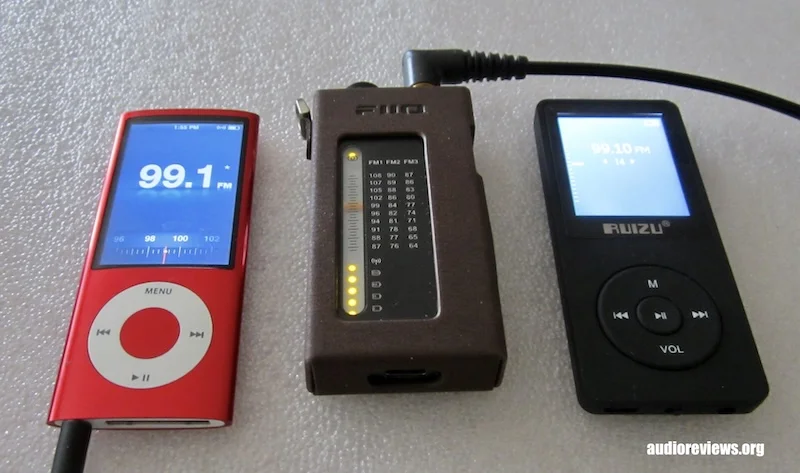
Sonic Performance
Obviously, a small radio is meant to be operated with earbuds or small headphones. I tested the RR11 with different headsets while walking through the neighbourhood. The included FiiO earbuds are – unsurprisingly – rather meh, I mainly used some old Sennheiser MX 560 bud, the Snowsky Wind, and Koss Porta Pro headphones. For checking its amplification power, I briefly used the 150 ohm Sennheiser HD 25, which are driven just fine.
The RR11’s radio sounds just like my analog 1990s Sony ICF-SW10 World Receiver: light note weight with good note separation, fluffy, open yet immersive, very lively. Just like any good old-fashioned transistor radio.
The sound is bassier with in-ears and bass light with earbuds. The 2-stage “Magic Bass” (FiiO’s equivalent to Sony’s legendary “Mega Bass”) helps to compensate for the earbuds design. One could broadly compare the sound to that from a digital source with a THX amp.
What’s really good in the RR11 is the selectivity/proximity selection. On my way around, the neighbourhood reception was very stable with not a single interference from other stations.
Accessories
FiiO offer a protective leather case with 2 lanyards of different lengths (price unknown at the time of writing this). To me, the good smelling leather case is a must.
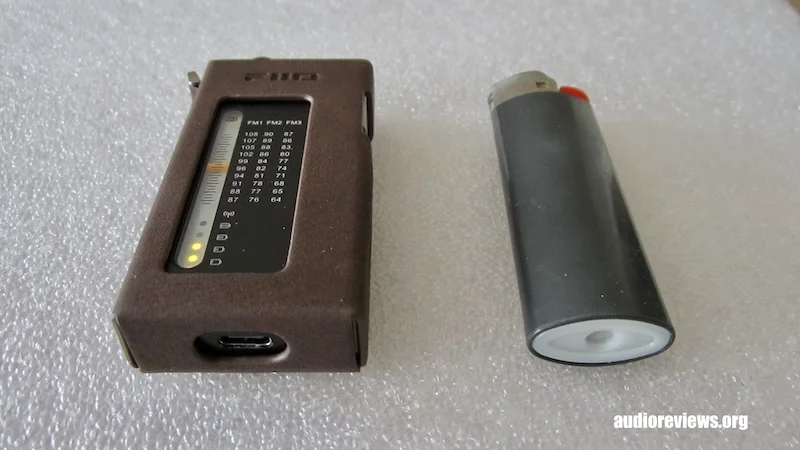
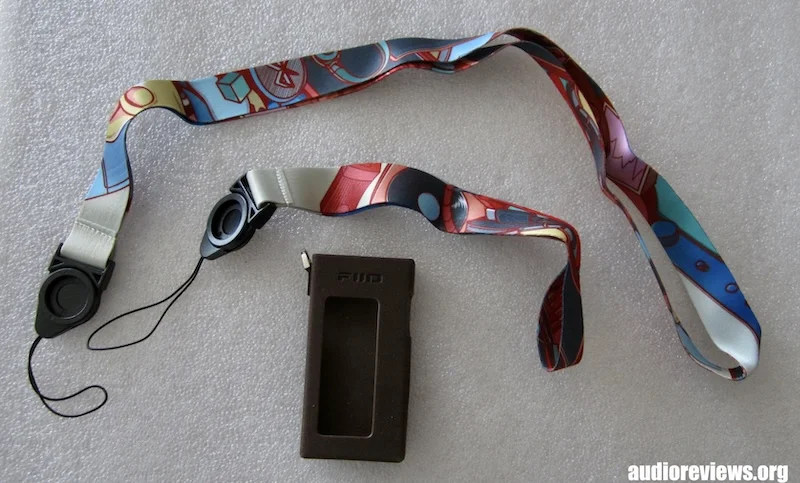
Concluding Remarks
The FiiO RR11 delivers what you expect: being a well-built compact radio with a compact sound. Optically, sonically, and operation wise, it is not different from 1980s and 1990s analog radios. Works fine, looks cool, and even better with the leather case. And it fits in every shirt pocket. What else do we need?
Until next time…keep on listening!

Disclaimer
Our generic standard disclaimer.





